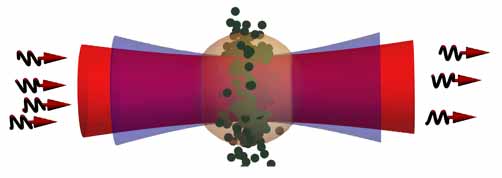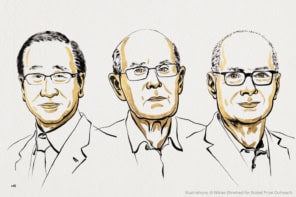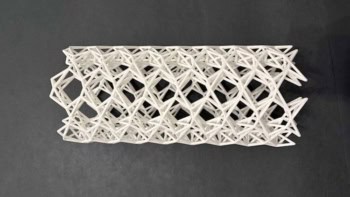
Physicists in Germany have created a new optical device that can absorb exactly one photon. They say that this device, which exploits the physical properties of giant micron-sized atoms known as Rydberg atoms, could be used in optical quantum computing networks of the future.
Sebastian Hofferberth of the University of Stuttgart explains that the device first behaves like a dark sunglasses lens, but once it absorbs its first photon it becomes transparent to light. One important application of the device, says Hofferberth, could be to absorb single photons from a quantum network. Another potential application is a precise photon counter, which could be made by putting a number of the devices in series.
Atomic cloud
At the heart of the device is a micron-sized diffuse cloud of rubidium atoms cooled to near-absolute-zero temperature. To make the cloud only absorb a single photon, it is first illuminated with laser light with precisely enough energy to excite the atoms’ outermost electron into the 121st energy level. There the electron is about a thousand times further from the nucleus than it would be in the atom’s ground state. Such atoms have radii of more than a micron and are known as Rydberg atoms.
When a rubidium atom in the cloud absorbs a single photon to become the first Rydberg atom, no other atom can accept another photon from the laser beam. This is because the first Rydberg atom’s outermost electron is so far from its nucleus that it overlaps with all the other atoms in the cloud, changing their electronic structures. “The presence of the first Rydberg atom has such a strong influence that it changes the resonance conditions for all the other atoms,” Hofferberth says, adding “Rydberg atoms can interact with its neighbours about 10 microns away”. Because no other atoms can absorb photons, the cloud becomes transparent.
To verify that only one photon had been captured, the researchers use the fact that the outer electron is loosely bound to the Rydberg atom’s nucleus. “They’re very fragile,” Hofferberth says. So to verify that the cloud only absorbed one atom, he and his colleagues converted the Rydberg atom into a rubidium ion by knocking the outermost electron away. Then, they counted how many rubidium ions were present – and measured only one.
Delicate process
Creating this photon absorber was experimentally difficult, Hofferberth says. While laser cooling and trapping the rubidium atoms is a standard technique, creating the atomic cloud and the single Rydberg atom is still a very delicate process.
The concept behind this single-photon absorber was first proposed in 2011, says Alexey Gorshkov, a physicist at the University of Maryland who has collaborated with Hofferberth in the past, but was not involved in this most recent work. “These guys have implemented it, which is pretty cool,” Gorshkov says. However, he points out that when the device absorbs a single photon, it also distorts the signal of subsequent photons passing through it, which may complicate its use in quantum information applications.
Hofferberth explains that his team’s overarching goal is to create an array of general tools to precisely add, subtract, and control individual photons. “We have now built the most primitive version of such a tool for manipulating light,” he says. “We can subtract exactly one photon.” A similar single photon absorber based on a different physical mechanism was unveiled in 2015 by Barak Dayan and colleagues at the Weizmann Institute of Science in Israel and it is too early to tell which will be a more effective tool. The next step, according to Hofferberth, is to create a device that does the reverse – a collection of atoms that can produce exactly one photon.
The research is described in Physical Review Letters
- There is much more about Rydberg atoms in “The rise of Rydberg physics“.



